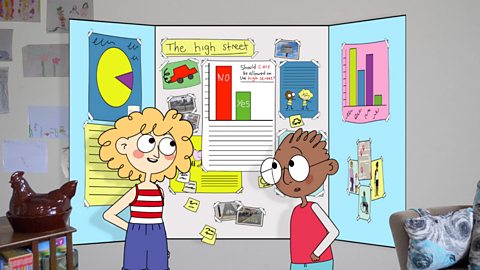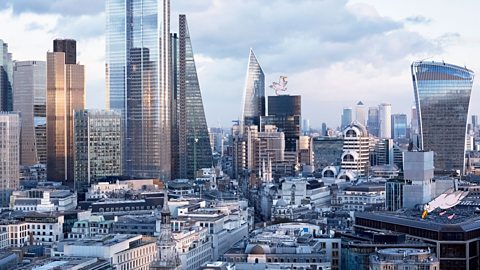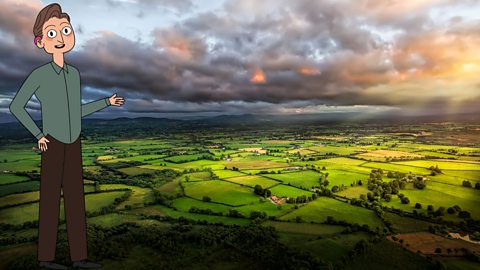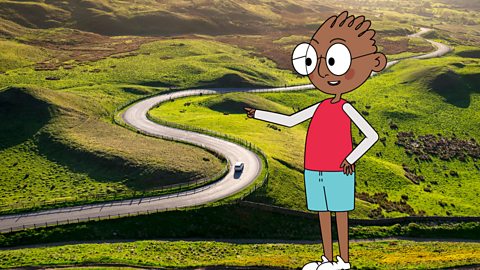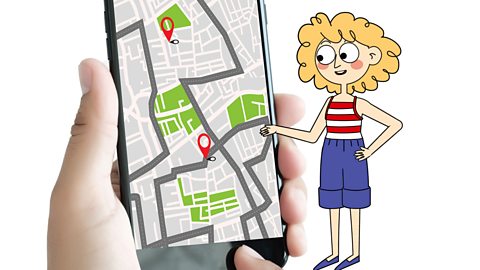What are different features?
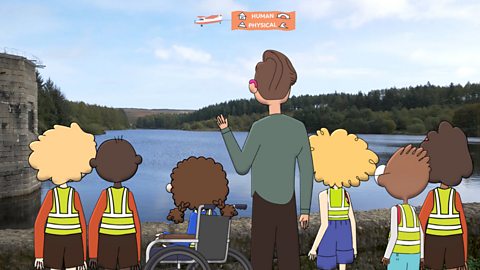
Human and physical features are things that you can see all around you.
Physical features like seas, mountains and rivers are natural. They would be here even if there were no people around.
Human features are things like houses, roads and bridges. They have been built by people.

Watch: Human and physical features
Play the video to watch Ben and Amber learn about human and physical features.
Ben: What are you looking at?
Amber: I'm trying to work out where we are on this map.
Ben: By the way that this bus keeps twisting and turning, I'd say that we're on that wiggly road there!
Amber: That’s not a road, that’s a river! I’m glad you’re not driving this bus, or we’d all be under water!
Mr Lewis: Is everything alright?
Amber: Yes, Mr. Lewis! We're trying to find out where we are on the map. Ben thinks this is a road, but I think it’s a river.
Mr Lewis: It's a bit confusing, isn't it? That's because the road follows the bends of the river in places. To make it straight the road builders would have had to build lots of bridges and tunnels, which cost a lot of money. Although they look similar on this map, the road and the river are examples of the two different types of geography: physical and human.
Amber: That sounds complicated!
Mr Lewis: Not really. Physical features are natural: they would be here even if people weren’t. Things like rivers, mountains and seas! Human features are made by people, like buildings, roads and bridges.
Amber: So that means the river is a physical feature?
Ben: And the road is a human feature?
Mr Lewis: That’s right! Let’s do a quiz! Work out which are physical features and which are human features. That church: is it a human or physical feature?
Ben: Human feature!
Mr Lewis: Correct! What about the hills?
Amber: Physical!
Mr Lewis: Spot on! Ah, we’ve arrived!
Ben: This is a lake. So it must be a physical feature?
Mr Lewis: It looks like a natural lake, doesn't it, but it was made by people around sixty years ago because they needed a place to store fresh water. Physical and human features affect each other in many ways. Sometimes the landscape changes what people build, like the winding road and sometimes what people build changes the landscape. Just like this lake!
Features on maps
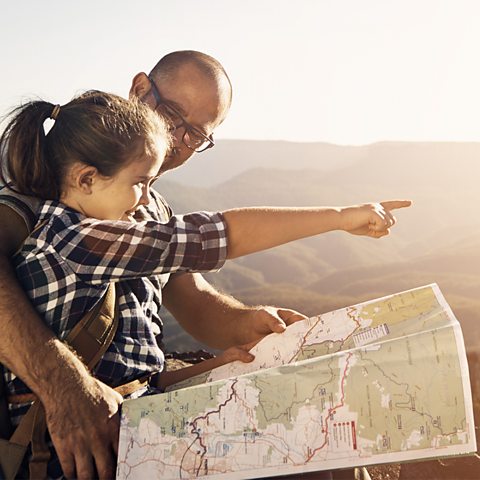
Maps can show:
- Just physical features - for example when people want to go walking in the mountains.
- Just human features - for example when people want to find their way around the streets in towns or cities.
- Both human and physical features - for example when people go walking in the countryside.
Have a look through different human and physical features:

Image caption, Physical features by the sea
Physical features include cliffs, the sea and waterfalls.
1 of 5
Watch: What geographical features are in national parks?
(UPBEAT MUSIC)
Amelle: Hi, I'm Amelle.
Daniel: And I'm Daniel.
And today we've come to a National Park in the Peak District to meet Matt, who is a park ranger.
Matt: Hi, Change Champs. It's so exciting to see you here. I've been a National Park Ranger for almost five years now, and I never get bored of spending all my time outside in this awesome place. Should we take a look around?
Kids: Yeah.
Matt: Come on, then.
(UPBEAT MUSIC)
So why do you think people come to a National Park like this then?
Daniel: To play.
Matt: To play? Yeah, that's a great thing to do here.
Amelle: Well, probably, maybe, like, maybe, like for picnics and stuff.
Matt: Totally. We love a picnic, yeah. Now one of the things I love about a National Park, id that's a great place to see loads of nature and wildlife. All these hills and trees and birds and everything, but we've also got loads of really cool man-made features too.
Like we've got a big reservoir here and over there behind us, that's the pumping house where they clean all the water and send it off to be your drinking water in the city. And down here behind us, we got the reservoir outflow, which takes all the water away. So there's loads of really cool things to see. Should we go have a look?
Amelle: Yeah.
Matt: Come on, then.
Amelle: What's a reservoir.
Matt: A reservoir, it's like a big lake, isn't it? Great big bowl of water. But it isn't natural, it's been made by people to store all the rain that falls here to keep for drinking water. You know, you guys are asking some great questions. I think it's time for a mission.
Amelle: Your mission is to identify as many human and physical geographical features as possible and draw them onto a map.
Daniel: Like a pirate map.
Matt: Right, let's go and start making our map. Okay. So for this mission, you're going to need to look at human and physical features in this place, all around us. So human features are things that people have built like that great big wall or the houses or roads, things like that.
And physical features are things that weren't put here by people. They're there because that's the way the land is. So the hills, the trees, things like that. So on our map, we're going to draw loads and loads of little pictures to show where things are.
Amelle: I see walls and trees.
Daniel: I can see hills in the distance.
Matt: It's really, really important that we have what's called a key to show us what all those different pictures mean. It's a bit like a secret code. Okay.
Oh, that is super.
Amelle: There were so many things created by nature here, but also so many things created by us humans.
Matt: So the big wires that go all the way along there, do you think they're natural, do you think they grew up out of the ground?
Amelle: No. They were man-made.
Matt: No. They're a human feature. A man-made feature, aren't they?
Oh, Change Champs, you've done an amazing job. That's a fantastic map. There's one last thing we need to do. And that's to put X marks the spot to show exactly where we are in your awesome map. Okay.
Amelle: So we're about there.
Matt: Well-done team, what an epic effort. You've really learned so much about the human and physical features that you can see in a National Park. But you can find human and physical features around you anywhere, even in your local park. Okay. I think we need to pack up and get going, don't we?
Daniel: We have really enjoyed learning from Matt.
Amelle: And I'm going to make a map next time I go to my local park.
You can find out even more about national parks with The Regenerators.
Activity 1: Human or physical?
Activity 2: Features around you
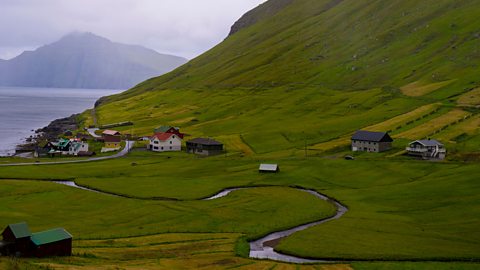
Next time you go out, try to spot human and physical features around you.
Maybe you could draw a map of them too with a key to explain what your symbols mean.

Activity 3: Human and physical features quiz
Resources for teachers
Looking for more resources to help your class get to grips with geography? Take your class on a learning adventure around the world with this series of short films.
BBC Teach has thousands of free, curriculum-linked resources to help deliver lessons - all arranged by subject and age group.
BBC Bitesize newsletter. External Link
Sign up to our BBC Bitesize newsletter to receive monthly news, stories and updates on latest Bitesize content.

More on Fieldwork
Find out more by working through a topic
- count3 of 6

- count6 of 6
